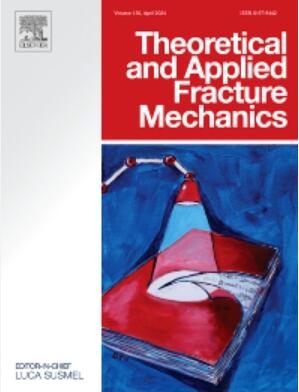Study on notch stress–strain response of blunt side-notched specimen with finite residual width
IF 5
2区 工程技术
Q1 ENGINEERING, MECHANICAL
引用次数: 0
Abstract
The stress–strain curve at the notch root can be an essential basis for studying the elastic–plastic deformation behavior of notched structure. However, current notch stress–strain studies rarely consider the effect of a finite residual size at the notch root. The blunt side-notched specimens with finite residual width are designed in this work. The material of side-notched specimen is the TC4 titanium alloy. The notch-root strain is measured using the 3D-DIC and an elastic–plastic finite element analysis is performed. It is found that the notch constraints of the finite residual width side-notched specimens are plane stress, which may not be affected by the notch-root radius of curvature. Experiment verification shows that both Neuber’s rule and ESED would underestimate the notch root strain in the plastic stage, and the main reason is that the stress concentration caused by the finite residual width is not considered. To compensate for the deficiency of the traditional method of describing stress concentrations using only Kt, a geometric concentration factor Kg is proposed. Kg can simultaneously reflect the effect of both Kt and the finite residual width on plastic deformation. By introducing the Kg, the accuracy of Neuber’s rule and ESED in describing notch stress–strain has been significantly improved.
求助全文
约1分钟内获得全文
求助全文
来源期刊

Theoretical and Applied Fracture Mechanics
工程技术-工程:机械
CiteScore
8.40
自引率
18.90%
发文量
435
审稿时长
37 days
期刊介绍:
Theoretical and Applied Fracture Mechanics'' aims & scopes have been re-designed to cover both the theoretical, applied, and numerical aspects associated with those cracking related phenomena taking place, at a micro-, meso-, and macroscopic level, in materials/components/structures of any kind.
The journal aims to cover the cracking/mechanical behaviour of materials/components/structures in those situations involving both time-independent and time-dependent system of external forces/moments (such as, for instance, quasi-static, impulsive, impact, blasting, creep, contact, and fatigue loading). Since, under the above circumstances, the mechanical behaviour of cracked materials/components/structures is also affected by the environmental conditions, the journal would consider also those theoretical/experimental research works investigating the effect of external variables such as, for instance, the effect of corrosive environments as well as of high/low-temperature.
 求助内容:
求助内容: 应助结果提醒方式:
应助结果提醒方式:


